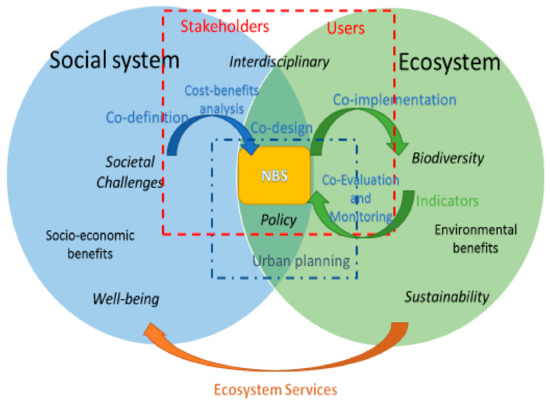1000/1000
Hot
Most Recent

| Version | Summary | Created by | Modification | Content Size | Created at | Operation |
|---|---|---|---|---|---|---|
| 1 | Thomas Panagopoulos | + 662 word(s) | 662 | 2020-02-04 10:55:54 | | | |
| 2 | Catherine Yang | + 2 word(s) | 664 | 2020-11-01 09:00:16 | | |
Application of Nature-based solutions face challenges and barriers. It is a recent concept that includes social and economic factors besides the environmental factors for successful and rapid implementation. Thus, the human component—indeed, stakeholder engagement is essential to the success of such initiatives. This literature review provide a complete picture of public participation in NBS processes. The objective was to understand the perceptions, preferences, and perspectives of different actors, the participation drivers and motivations, the participation methods and frameworks, the collaborative governance, and the participation challenges and opportunities in implementation of nature-based solutions in urban areas.
Due to the current challenges of rapid urbanization and climate change, quality of life and resilience of cities have gained political impetus in the last decade. Cities are facing a broad range of challenges, such as human health issues, social inequity, environmental degradation, loss of natural capital, decreased rate of ecosystem services, and readiness to deal with natural disasters[1].
The concept of biophilia advanced the idea that contact with nature plays a fundamental role in human well-being[2]. Additionally, there was an emerging need of using natural components and their multiple functions, to increase sustainable development into the cities. The importance of nature and its functions in cities have been studied for many years. Nature-based solutions have largely evolved from previous ecosystem-based concepts and/or principles (e.g., ecosystem services, green infrastructures, ecosystem-based management, and natural capital), but it also pays attention to the social and economic benefits of resource-efficient and universal solutions that combine technical, business, finance, governance, regulatory, and social innovation[3]. The definition of NBS proposed by the European Commission assumes an understanding of the concept similar to the approach followed in the current work: “as solutions that are inspired and supported by nature, which are cost-effective, simultaneously provide environmental, social and economic benefits and help build resilience. Such solutions bring more, and more diverse, nature and natural features and processes into cities, landscapes and seascapes, through locally adapted, resource-efficient and systemic interventions.”[4]
The stakeholder involvement in urban green infrastructure (GI), including urban forest (UF) or urban green space (UGS), is not new and has greatly advanced in recent decades[5]. However, looking at the more recent NBS concept the human context is critical and is gaining increasing attention from scientists and practitioners as potential solutions to enhance socio-ecological systems resilience. More attention should be given to the incorporation of local and indigenous knowledge into formulating and applying solutions[6]. Though, the involvement of locals is still rarely adopted; mainly resulting from the general perception that multi-stakeholder initiatives slow down urban planning and policy development processes due to a lack of consensus.
Figure 1 represents a conceptual understanding of NBS, their benefits, planning process, and implementation. The various links within and between ecological and social systems are accounted for in the process. We consider that NBS needs to be embedded in the existing policies, supported by urban planning and adopted in joint dialogues between policy, society, and science. Urban planning can contribute with spatial information for decision support concerning the choice for the location of projects and how they relate with societal challenges, the identification of alternative solutions, and the measurement of their respective impacts[7]. Nature-based solutions enhance natural capital and promote biodiversity while delivering ecosystem services and other co-benefits like improved health and well-being.

Figure 1. Conceptual understanding of nature-based solutions.[8]
The aim of this systematic literature review was to bring up the role played by the participation of stakeholders and citizens on the identification of problems and solutions for the rapid and efficient application of NBS. The focus of the review was associated to five research questions about the perceptions, preferences, and perspectives of the citizens and stakeholders; motivations for the citizens’ and stakeholders’ engagement; benefits and costs resulting from the participation processes; barriers and opportunities raised by the engagement of stakeholders; and the approaches in collaborative governance of participatory processes during NBS implementation.